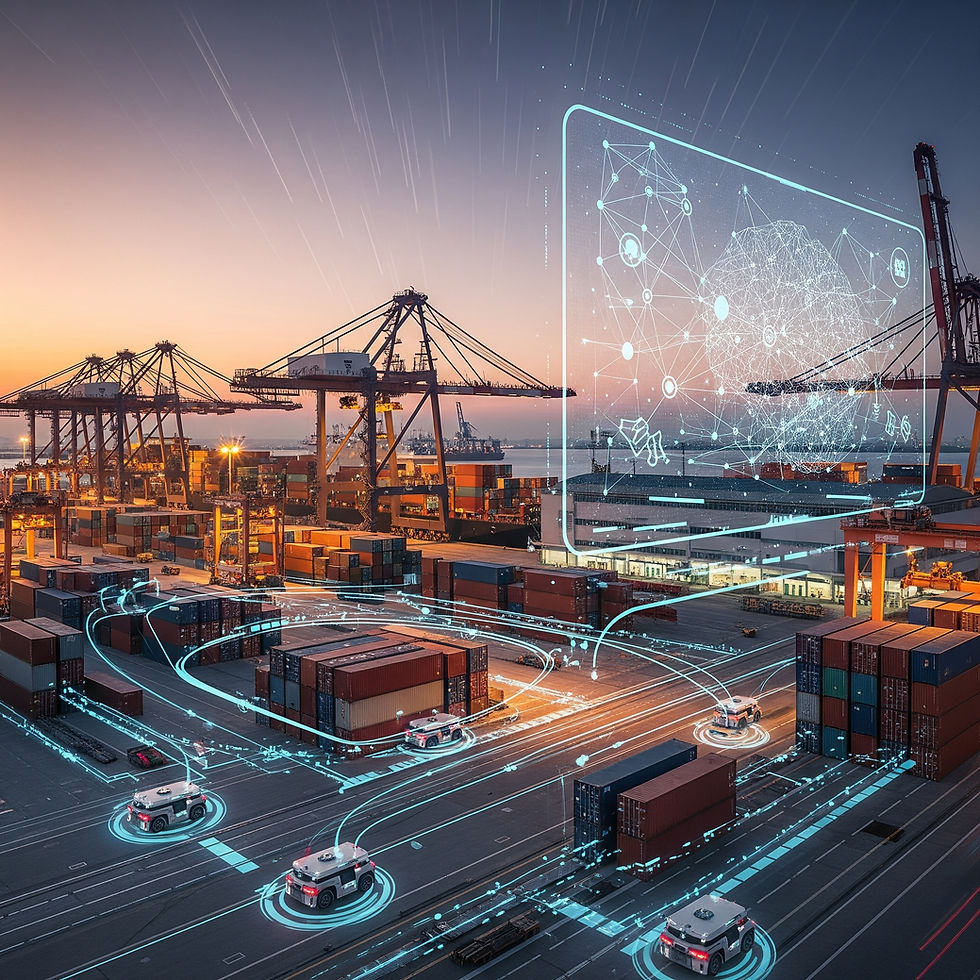What Is Agentic AI And Why It Matters in Logistics
- Chris Ruddick
- Aug 20
- 4 min read
Updated: Aug 26
Artificial Intelligence (AI) is expected to revolutionize nearly every industry, and logistics is no exception. Within the AI landscape, a new paradigm is emerging: agentic AI. While traditional automation tools follow predefined logic and fixed workflows, agentic AI systems can reason, adapt, and act autonomously in response to complex and dynamic situations.
In this article, we’ll explore what agentic AI actually is, how it differs from traditional workflow automation, and where it fits within the broader landscape of supply chain and logistics technology. We’ll also explain why platforms like ours (the Splice automation engine is purpose-built for supply chain and logistics) are a crucial foundation and how agentic AI may complement them in the future.

What Is Agentic AI?
Agentic AI refers to AI systems that behave as autonomous agents: software components capable of perceiving their environment, reasoning about it, and making decisions to achieve goals. In practice. This means:
Interpreting messy or ambiguous input (like human language or a noisy dataset)
Choosing from available tools or APIs
Executing actions (like submitting a shipment booking or sending a follow-up email)
Reflecting on the results and deciding what to do next
Unlike rule-based systems or workflow engines, agentic AI systems are not bound to predefined paths. Instead, they use large language models (LLMs) like OpenAI's GPT-4 or Anthropic's Claude to dynamically decide the next step in a process.
For example, instead of creating a fixed sequence for booking a shipment:
"If carrier == UPS, use API X. Else, use API Y."
An agentic system might receive a request like:
"Ship this to Paris using the fastest available option."
Then it would:
Search available carrier integrations
Analyze transit times and cost
Pick the most appropriate API
Execute the call
Report back to the user
It acts more like a human logistics coordinator, but powered by software.
How Agentic AI Differs from Traditional Automation
Most logistics operations today use workflow automation tools, like Zapier, Make, or our platform Splice (an integration platform as a service - iPaaS), which are excellent for repeatable, structured processes - and in our case is dedicated to solving supply chain/logistics problems. These tools trigger actions when defined conditions are met:
New order created → send email → create shipment → notify carrier
But these flows require human-designed logic. If something unexpected happens -- like a missing address or a failed API call -- the system typically stops or throws an error. Agentic AI introduces a new layer of intelligence.
Here's a real-world comparison:
Traditional Workflow: "Every time a tracking update is received, send it to the customer."
Agentic AI Workflow: "If a delay is detected, analyze impact on delivery date, notify the customer, and suggest re-routing if needed."
Comparison of Traditional Automation vs. Agentic AI
Feature | Traditional Automation | Agentic AI |
Behavior | Deterministic | Adaptive & autonomous |
Setup | Predefined rules | Goal-based prompts |
Error Handling | Stops or fails | Re-plans dynamically |
Decision-Making | Hardcoded paths | Chooses tools at runtime |
Language Support | Limited | Understands natural language |
Why Agentic AI Matters in Logistics
Supply chain and logistics are full of exceptions, edge cases, and unstructured data. Human operators often need to:
Interpret vague emails
Match data across systems
Make judgement calls based on incomplete info
Re-plan deliveries on the fly
Agentic AI is uniquely suited to assist or automate tasks like:
Quoting and booking across multiple carriers with different APIs
Reading BOLs, rate confirmations, or customs documents
Responding to customer support tickets in natural language
Monitoring exceptions and resolving issues proactively
By introducing reasoning into automation, agentic systems can fill the gap between humans and traditional systems.
Where Agentic AI Falls Short
While promising, agentic AI has current limitations:
Tool integration is still manual: The agent can't auto-discover your APIs
Token limits: LLMs have context limits that constrain multi-step workflows
Data accuracy: LLMs can hallucinate or misinterpret structured data
Complex APIs: Many shipping APIs are too complex for current LLM agents without simplification
That's where platforms for logistics like Splice shine: we provide reliable, secure, and observable automation infrastructure. Our users can build robust integrations and workflows that can, in the future, be enhanced with agentic reasoning.
Workflow Automation Today, Agentic AI Tomorrow
Agentic AI represents an exciting frontier in logistics automation. It doesn’t replace workflow automation — it augments it. For now, logistics teams should focus on:
Digitizing and integrating core processes using workflow automation platforms like ours
Designing APIs and data flows that could be consumed by future AI agents
Identifying high-friction, exception-heavy tasks where AI could provide value
As the technology matures, we expect to offer agentic AI tools that can plug into our automation ecosystem. Our mission is to help logistics teams automate smarter—and that includes preparing for the age of intelligent agents.
Learn More - Get Started
Subscribe to our newsletter to follow our series on AI in supply chain and logistics.

Comments